DIGITAL TRANSMISSION
DIGITAL TRANSMISSION
* Data transmission and data reception is the transfer and reception of data over a point-to-point or point-to-multipoint communication channel. Examples of such channels are copper wires, optical fibers, wireless communication channels, storage media and computer buses.
* Digital transmission is employed in order to achieve high reliability and because the cost of digital switching systems is much lower than the cost of analog systems.
* For a computer to use the data, it must be in discrete digital form. Similar to data, signals can also be in analog and digital form. To transmit data digitally, it needs to be first converted to digital form.
* Digital Transmission is the transmission of signals that vary discretely with time between two values of some physical quantity, one value representing the binary number 0 and the other representing 1.
* There are two methods used to transmit data between digital devices: serial transmission and parallel transmission.
* The major difference between both signals is that the analog signals have continuous electrical signals, while digital signals have non-continuous electrical signals.
* Digital signals are transmitted to computers in the form of electronic signals sent as pulses. The digital device interprets each pulse's voltage as either a 0 or 1.
* The computers used the digital form to store the information. Therefore, the data needs to be converted in digital form so that it can be used by a computer.
DIGITAL - TO - DIGITAL CONVERSION
* Digital-to-digital encoding is the representation of digital information
by a digital signal. When binary 1s and 0s generated by the computer
are translated into a sequence of voltage pulses that can be propagated
over a wire, this process is known as digital-to-digital encoding.

* Encoding is the process of using various patterns of voltage or current levels to represent 1s and 0s of the digital signals on the transmission link. The common types of line encoding are Unipolar, Polar, Bipolar, and Manchester.
LINE CODING
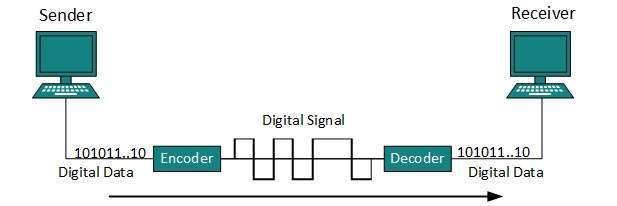
* Digital signal is denoted by discreet signal, which represents digital
data.There are three types of line coding schemes available:
- Unipolar Encoding
- Polar Encoding
- Bipolar Encoding
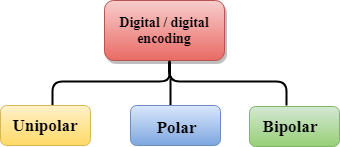
* Digital encoding or Line coding, both are same.
UNIPOLAR
- Digital transmission system sends the voltage pulses over the medium link such as wire or cable.
- In most types of encoding, one voltage level represents 0, and another voltage level represents 1.
- The polarity of each pulse determines whether it is positive or negative.
- This type of encoding is known as Unipolar encoding as it uses only one polarity.
- In Unipolar encoding, the polarity is assigned to the 1 binary state.
- In this, 1s are represented as a positive value and 0s are represented as a zero value.
- In Unipolar Encoding, '1' is considered as a high voltage and '0' is considered as a zero voltage.
- Unipolar encoding is simpler and inexpensive to implement.
- In this case, to represent binary 1, high voltage is transmitted and to represent 0, no voltage is transmitted. It is also called Unipolar-Non-return-to-zero, because there is no rest condition i.e. it either represents 1 or 0.
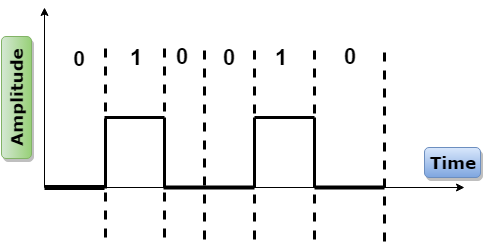
Unipolar encoding has two problems that make this scheme less desirable:
- DC Component
- Synchronization
* When the voltage level in a digital signal is constant for a while, the spectrum creates very low frequencies, called DC components, which present problems for a system that cannot pass low frequencies.
* Its drawbacks are that it is not self-clocking and it has a significant DC component, which can be halved by using return-to-zero, where the signal returns to zero in the middle of the bit period. With a 50% duty cycle each rectangular pulse is only at a positive voltage for half of the bit period. This is ideal if one symbol is sent much more often than the other and power considerations are necessary, and also makes the signal self-clocking.
POLAR
- Polar encoding scheme uses multiple voltage levels to represent binary values.
- Polar encoding is an encoding scheme that uses two voltage levels: one is positive, and another is negative.
- By using two voltage levels, an average voltage level is reduced, and the DC component problem of unipolar encoding scheme is alleviated(reduced).
- Polar encodings is available in four types: Polar Non-Return to Zero (Polar NRZ), Return to Zero (RZ), Manchester, Differential Manchester.
NRZ (Non-Return to Zero)
- NRZ stands for Non-return to zero.
- In NRZ encoding, the level of the signal can be represented either positive or negative.
- It uses two different voltage levels to represent binary values. Generally, positive voltage represents 1 and negative value represents 0. It is also NRZ because there is no rest condition.
- NRZ scheme has two variants: NRZ-L and NRZ-I.
- NRZ-L changes voltage level at when a different bit is encountered whereas NRZ-I changes voltage when a 1 is encountered.
NRZ-L:
* NRZ-L changes voltage level at when a different bit is encountered.
* In NRZ-L encoding, the level of the signal
depends on the type of the bit that it represents.
* If a bit is 0 or 1, then their voltages will be positive and negative respectively. Therefore, we can say that the level of the signal is dependent on the state of the bit.
NRZ-I:
* NRZ-I changes voltage when a 1 is encountered.
* NRZ-I is an inversion of the voltage level that represents 1 bit.
* In the NRZ-I encoding scheme, a transition occurs between the positive and negative voltage that represents 1 bit.
* In this scheme, 0 bit represents no change and 1 bit represents a change in voltage level.
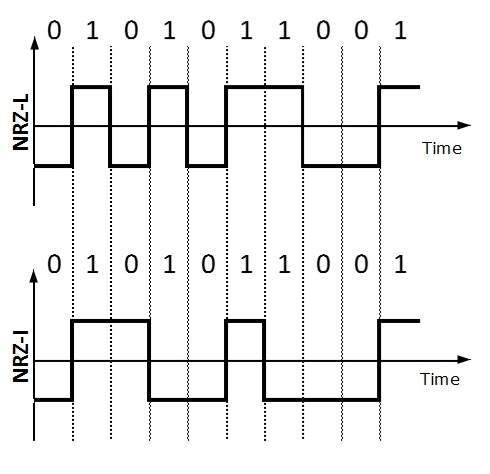
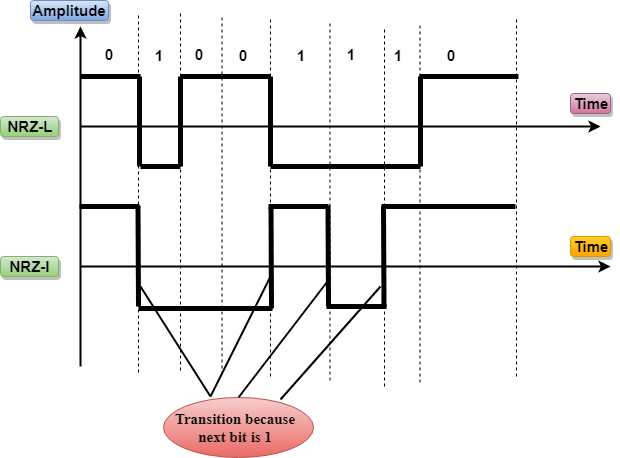
Problem with NRZ is that the receiver cannot conclude when a bit ended
and when the next bit is started, in case when sender and receiver’s
clock are not synchronized. Thus, RZ comes.
RZ
- RZ stands for Return to zero.
- There must be a signal change for each bit to achieve synchronization. However, to change with every bit, we need to have three values: positive, negative and zero.
- RZ is an encoding scheme that provides three values, positive voltage represents 1, the negative voltage represents 0, and zero voltage represents none.
- In the RZ scheme, halfway through each interval, the signal returns to zero.
- In RZ scheme, 1 bit is represented by positive-to-zero and 0 bit is represented by negative-to-zero.
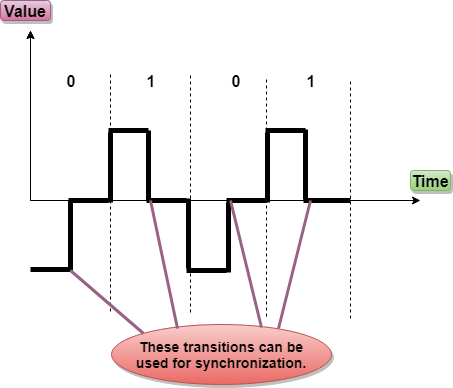
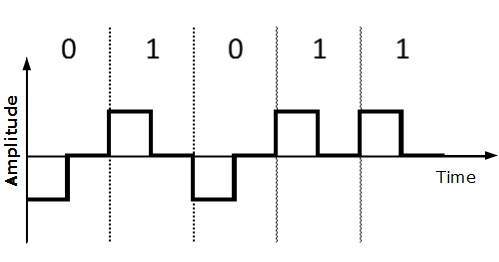
Disadvantage of RZ:
It performs two signal changes to encode one bit that acquires more bandwidth.
BIPHASE
- Biphase is an encoding scheme in which signal changes at the middle of the bit interval but does not return to zero.
- Biphase encoding is implemented in two different ways: Manchester, and Differential Manchester.
MANCHESTER
- It changes the signal at the middle of the bit interval but does not return to zero for synchronization.
- In Manchester encoding, a negative-to-positive transition represents binary 1, and positive-to-negative transition represents 0.
- Manchester has the same level of synchronization as RZ scheme except that it has two levels of amplitude.
ADVERTISEMENT
DIFFERENTIAL MANCHESTER
- It changes the signal at the middle of the bit interval for synchronization, but the presence or absence of the transition at the beginning of the interval determines the bit.
- A transition means binary 0 and no transition means binary 1.
- In Manchester Encoding scheme, two signal changes represent 0 and one signal change represent 1.
BIPOLAR
- Bipolar encoding scheme represents three voltage levels: positive, negative, and zero.
- In Bipolar encoding scheme, zero level represents binary 0, and binary 1 is represented by alternating positive and negative voltages.
- If the first 1 bit is represented by positive amplitude, then the second 1 bit is represented by negative voltage, third 1 bit is represented by the positive amplitude and so on. This alternation can also occur even when the 1bits are not consecutive.
Bipolar can be classified as:
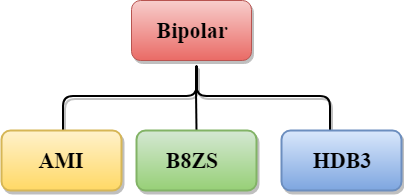
AMI
- AMI stands for alternate mark inversion where mark work comes from telegraphy which means 1. So, it can be redefined as alternate 1 inversion.
- In Bipolar AMI encoding scheme, 0 bit is represented by zero level and 1 bit is represented by alternating positive and negative voltages.
Advantage:
ADVERTISEMENT
- DC component is zero.
- Sequence of 1s bits are synchronized.
Disadvantage:
- This encoding scheme does not ensure the synchronization of a long string of 0s bits.
B8ZS
- B8ZS stands for Bipolar 8-Zero Substitution.
- This technique is adopted in North America to provide synchronization of a long sequence of 0s bits.
- In most of the cases, the functionality of B8ZS is similar to the bipolar AMI, but the only difference is that it provides the synchronization when a long sequence of 0s bits occur.
- B8ZS ensures synchronization of a long string of 0s by providing force artificial signal changes called violations, within 0 string pattern.
- When eight 0 occurs, then B8ZS implements some changes in 0s string pattern based on the polarity of the previous 1 bit.
- If the polarity of the previous 1 bit is positive, the eight 0s will be encoded as zero, zero, zero, positive, negative, zero, negative, positive.
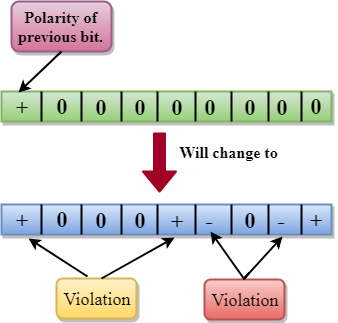
ADVERTISEMENT
- If the polarity of previous 1 bit is negative, then the eight 0s will be encoded as zero, zero, zero, negative, positive, zero, positive, negative.
HDB3
- HDB3 stands for High-Density Bipolar 3.
- HDB3 technique was first adopted in Europe and Japan.
- HDB3 technique is designed to provide the synchronization of a long sequence of 0s bits.
- In the HDB3 technique, the pattern of violation is based on the polarity of the previous bit.
- When four 0s occur, HDB3 looks at the number of 1s bits occurred since the last substitution.
- If the number of 1s bits is odd, then the violation is made on the fourth consecutive of 0. If the polarity of the previous bit is positive, then the violation is positive. If the polarity of the previous bit is negative, then the violation is negative.
If the number of 1s bits since the last substitution is odd.
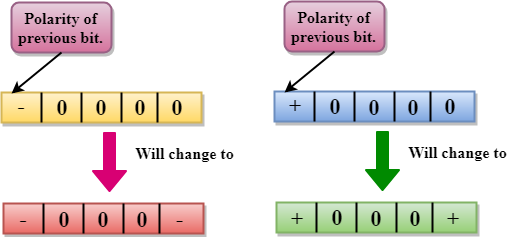
If the number of 1s bits is even, then the violation is made on the place of the first and fourth consecutive 0s. If the polarity of the previous bit is positive, then violations are negative, and if the polarity of the previous bit is negative, then violations are positive.
If the number of 1s bits since the last substitution is even.
ADVERTISEMENT
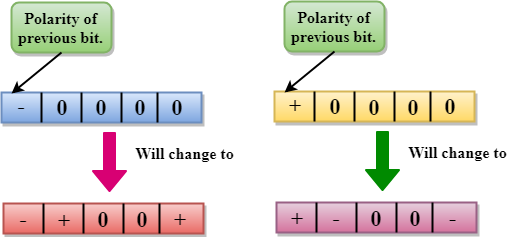



Comments
Post a Comment